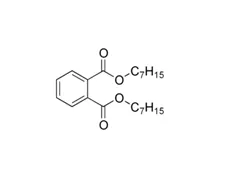1,2-benzenedicarboxylic acid, di-C6-8-branched alkyl esters, C7-rich and REACH authorisation: what you must know

Identity of 1,2-benzenedicarboxylic acid, di-C7-11-branched and linear alkyl esters
Name Acide 1 2-benzènedicarboxylique esters alkyliques ramifiés di-c7-11
IUPAC name Di-C7-11-(linear and branched)-alkyl phthalate
CAS number 68515-42-4
EC number 271-084-6
Chemical formula C22H34O4 - C30H50O4
Hazard classification of 1,2-benzenedicarboxylic acid, di-C7-11-branched and linear alkyl esters
VERY HAZARDOUS TO HEALTH
● H350: May cause cancer
● H340: May cause genetic defects
● H360: May damage fertility or the unborn child
● H371: May cause damage to organs
● H304: May be fatal if swallowed and enters airways
● H334: May cause allergy or asthma symptoms or breathing difficulties if inhaled
1,2-benzenedicarboxylic acid, di-C7-11-branched and linear alkyl esters in annex XIV of REACH
Key regulatory information
Intrinsic property for which it was included in Annex XIV of REACH Toxic for reproduction (category 1B)
Sunset date 4 July 2020
Latest date to submit the authorisation dossier to ECHA 4 January 2019
Who is concerned by REACH authorisation? Main industries concerned Polymers
EcoMundo’s advice to succeed in your authorisation application
Recommendations for your authorisation dossier
- As the substance does not have a threshold, the Socio-Economic Analysis route will be chosen. This analysis will demonstrate that the benefits related to the granting of the authorisation outweigh the risks associated.
- The applicant will thus have to conduct a socio-economic analysis as well as the CSR and Analysis of Alternatives.
- The preferred methodology to conduct the socio-economic analysis of the authorisation application is the cost/benefit analysis.
- The creation of a dossier is usually between 6 and 18 months depending on the complexity of the dossier (intrinsic properties of the substance, complexity of the applicants’ value and production chain.
- Key elements of a successful authorisation dossier:
- A specific request with the most elements possible in relation to your activity
- Transparence and realism of the hypotheses and data as all elements produced will be challenged by the committees or stakeholders
- The “applied for use” and “non-use” scenarios are essential for the relevance of the socio-economic analysis
Planning recommendations
- The Latest Application date for this substance is 04/01/2019, the last submission window is on November 2018.
- It is therefore recommended to start the creation of the dossier immediately (september 2017).
Identity of 1,2-benzenedicarboxylic acid, di-C7-11-branched and linear alkyl esters
Name Acide 1 2-benzènedicarboxylique esters alkyliques ramifiés di-c7-11
IUPAC name Di-C7-11-(linear and branched)-alkyl phthalate
CAS number 68515-42-4
EC number 271-084-6
Chemical formula C22H34O4 - C30H50O4
Hazard classification of 1,2-benzenedicarboxylic acid, di-C7-11-branched and linear alkyl esters
VERY HAZARDOUS TO HEALTH
● H350: May cause cancer
● H340: May cause genetic defects
● H360: May damage fertility or the unborn child
● H371: May cause damage to organs
● H304: May be fatal if swallowed and enters airways
● H334: May cause allergy or asthma symptoms or breathing difficulties if inhaled
1,2-benzenedicarboxylic acid, di-C7-11-branched and linear alkyl esters in annex XIV of REACH
Key regulatory information
Intrinsic property for which it was included in Annex XIV of REACH Toxic for reproduction (category 1B)
Sunset date 4 July 2020
Latest date to submit the authorisation dossier to ECHA 4 January 2019
Who is concerned by REACH authorisation? Main industries concerned Polymers
EcoMundo’s advice to succeed in your authorisation application
Recommendations for your authorisation dossier
- As the substance does not have a threshold, the Socio-Economic Analysis route will be chosen. This analysis will demonstrate that the benefits related to the granting of the authorisation outweigh the risks associated.
- The applicant will thus have to conduct a socio-economic analysis as well as the CSR and Analysis of Alternatives.
- The preferred methodology to conduct the socio-economic analysis of the authorisation application is the cost/benefit analysis.
- The creation of a dossier is usually between 6 and 18 months depending on the complexity of the dossier (intrinsic properties of the substance, complexity of the applicants’ value and production chain.
- Key elements of a successful authorisation dossier:
- A specific request with the most elements possible in relation to your activity
- Transparence and realism of the hypotheses and data as all elements produced will be challenged by the committees or stakeholders
- The “applied for use” and “non-use” scenarios are essential for the relevance of the socio-economic analysis
Planning recommendations
- The Latest Application date for this substance is 04/01/2019, the last submission window is on November 2018.
- It is therefore recommended to start the creation of the dossier immediately (september 2017).







